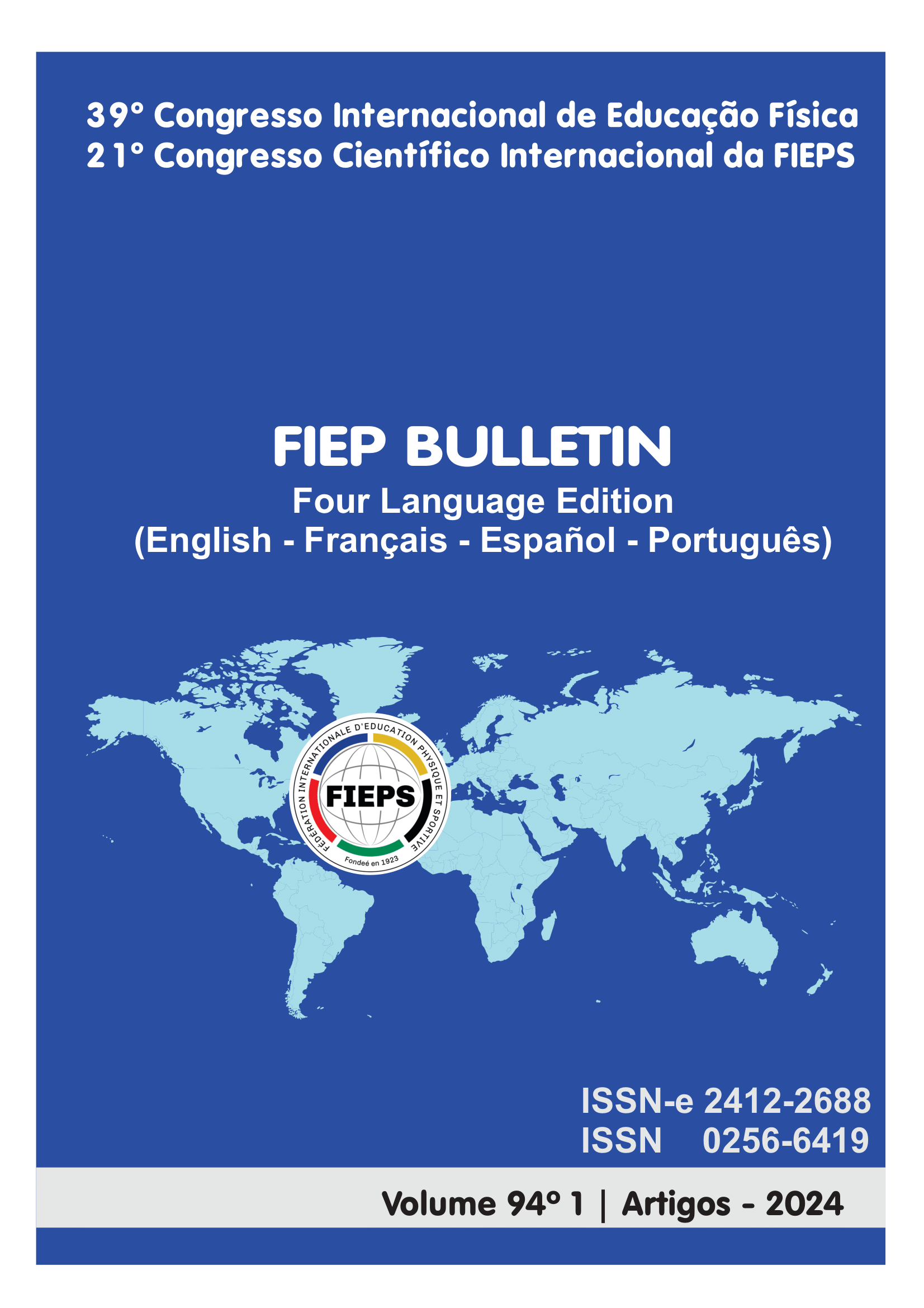NÍVEL DE FLEXIBILIDADE EM ESTUDANTES DE CAMPINA GRANDE-PB
DOI:
https://doi.org/10.16887/fiepbulletin.v94i1.6844Abstract
Introduction: Flexibility is understood as the ability of a joint to move within a maximum range of motion without causing injuries to the body. It is one of the components of physical fitness and is related to factors such as gender, age, and level of physical activity, among others. Having a satisfactory level of flexibility directly influences the improvement of an individual's quality of life for everyday activities. Objective: To assess the level of flexibility, compared by gender, among students from a private school in the city of Campina Grande-PB. Methods: The field test was conducted on a sports court, evaluating 64 students, with 36 males and 28 females. The method used was the "Sit and Reach Test" (SRT), proposed by Wells and Dillon, using a Wells bench. Results: Female students achieved higher scores and better rankings on the Wells bench compared to male students. Conclusion: Female students demonstrated a better degree of joint flexibility in the hip and spine, as well as muscular extensibility of the hamstring muscles, compared to male students.
Downloads
References
ACSM. American College of Sports Medicine. Diretrizes do ACSM para os testes de esforço e sua prescrição. 9 ed. Rio de Janeiro: Gunabara Koogan, 2014.
BEZERRA, E.S.; MARTINS, S. L.; LEITE, T. B.; PALADINO, D. V.; ROSSATO, M.; SIMÃO, R. Influência da modificação do teste de sentar e alcançar sobre o indicador de flexibilidade em diferentes faixas etárias. Rev. Motricidade, v. 11, n. 3, 2015, p. 3-10. DOI: https://doi.org/10.6063/motricidade.2336
BRASIL. Conselho Nacional de Saúde-CNS. Resolução CNS n° 510, de 07 de abril de 2016. Brasília. DOU nº 98, terça-feira, 24 de maio de 2016 - seção 1, p. 44-46.
CORTEZ, G. G.; DIAS, N. P.; TERÇARIOL, S. G. Níveis de flexibilidade entre escolares no século XXI em comparação com padrões estabelecidos no século passado. 2017. Disponível em: https://www.fisiosale.com.br/tcc/2017/giullia_nathalia.pdf. Acesso em: 06 jul. 2023.
CSTF. Canadian Standardized Test of Fitness. Operations Manual. 3rd Ed. Ottawa: Fitness and Amateur Sport, Canada, 1986.
FARINATTI, P. de T. V. Flexibilidade e esporte: uma revisão da literatura. Revista Paulista De Educação Física, 14(1), 85-96, 2000. Disponível em: https://doi.org/10.11606/issn.2594-5904.rpef.2000.138021. Acesso em: 20 set. 2023 DOI: https://doi.org/10.11606/issn.2594-5904.rpef.2000.138021
GONÇALVES, G.; DORNELES, G.; BUHRING, R. L.; KRUG, M. R. Análise da flexibilidade dos acadêmicos de Educação Física da Universidade de Cruz Alta. Rev Gestão Universitária, v. 345, 2019, p 1-6. Disponível em: http://www.gestaouniversitaria.com.br/artigos/analise-da-flexibilidade-dos-academicos-de-educacao-fisica-da-universidade-de-cruz-alta. Acesso em: 20 jul. 2023.
HEYWARD, V. H. Avaliação física e prescrição de exercício: técnicas avançadas. 6. ed. Porto Alegre: Artmed, 2013. 476 p.
LIMA L.R.A; MENEZES, E.C.; TENÓRIO, T.R.S.; MENDONÇA, B.C.A.; RODRIGUES, N.A.; VICTO, E.R.; ESTRADA-SALDAÑA, E.; STIGL-ZÚÑIGA, I.; ZÚÑIGA-SILVÍ, J.; FERRARI, G . Flexibility of Brazilian children and adolescents: a systematic review of the literature. Rev Bras Cineantropom Desempenho Hum, 2022, 24:e87232. Disponível em: https://doi.org/10.1590/1980-0037.2022v24e87232. Acesso em: 05 ago. 2023. DOI: https://doi.org/10.1590/1980-0037.2022v24e87232
MARTINS-COSTA, H. C.; ARAÚJO, S. R. S.; LIMA, F. V.; MENZEL, H. J.; FERNANDES, A. P.; CHAGAS, M. H. Análise do perfil , flexibilidade de crianças e adolescentes mensurada por meio de dois testes. Ver. Educ. Fís/UEM, v. 26, n. 2, p. 257-265, 2. trim, 2015. Disponível em: https://periodicos.uem.br/ojs/index.php/RevEducFis/article/view/22871/15238. Acesso em: 12 ago. 2023. DOI: https://doi.org/10.4025/reveducfis.v26i2.22871
MINATTO, G.; RIBEIRO, R.; JUNIOR, A. A.; SANTOS, K. D. Idade, maturação sexual, variáveis antropométricas e composição corporal: influências na flexibilidade. Revista Brasileira de Cineantropometria & Desempenho Humano. v. 12, n. 3, p 35-45, 2010. Disponível em: https://www.scielo.br/pdf/rbcdh/v12n3. Acesso em: 11 ago. 2023. DOI: https://doi.org/10.5007/1980-0037.2010v12n3p151
MUNIZ, M. A. B.; PEDRASSANI, C.; SOUZA, W. C.; SOUZA, W. B. Nível de flexibilidade de alunos do ensino médio da escola de educação básica “Almirante Barroso”. EFDesportes.com, Revista Digital, Buenos Aires, Año 18, Nº 190, Marzo de 2014. Disponível em: https://www.efdeportes.com/efd190/flexibilidade-de-alunos-do-ensino-medio.htm. Acesso em: 10 ago. 2023.
SANTIAGO, R. O.; DUARTE, A. C. M. B.; CATUNDA, F. N.; FEITOSA, W. G. Banco de Wells e Dillon e sua funcionalidade na obtenção de medidas do componente físico flexibilidade. FIEP BULLETIN, vol. 82, article Z, 2012. Disponível em: http://fiepbulletin.net/fiepbulletin/article/view/2130,4525. Acesso em: 11 jun. 2023.
Downloads
Published
Issue
Section
License
Autores que publicam nesta revista concordam com os seguintes termos:- Autores mantém os direitos autorais e concedem à revista o direito de primeira publicação, com o trabalho simultaneamente licenciado sob a Licença Creative Commons Attribution que permite o compartilhamento do trabalho com reconhecimento da autoria e publicação inicial nesta revista.
- Autores têm autorização para assumir contratos adicionais separadamente, para distribuição não-exclusiva da versão do trabalho publicada nesta revista (ex.: publicar em repositório institucional ou como capítulo de livro), com reconhecimento de autoria e publicação inicial nesta revista.
- Autores têm permissão e são estimulados a publicar e distribuir seu trabalho online (ex.: em repositórios institucionais ou na sua página pessoal) a qualquer ponto antes ou durante o processo editorial, já que isso pode gerar alterações produtivas, bem como aumentar o impacto e a citação do trabalho publicado (Veja O Efeito do Acesso Livre).










